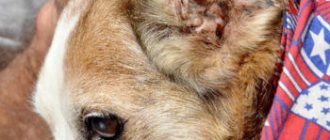05/09/2019 Drozd Nikolaevich Animals 18
The appearance of pimples on a dog's face always frightens the owner. After all, this not only spoils the appearance of the animal. In many cases, rashes are one of the signs of skin diseases, and sometimes pathologies of internal organs. How dangerous is acne? And how to improve the condition of your pet's skin? We will answer these questions in the article.
What do rashes look like?
Pimples on the face of dogs look like white or red bumps. They can be single, but often cover fairly large areas of the skin. Red rashes indicate inflammation, and whiteheads are a sign of suppuration.
Sometimes you can notice black pimples on a dog's chin. They look like little dots. These rashes appear due to clogged pores and are similar to human comedones. The appearance of blackheads most often indicates insufficient hygiene of the animal or an excess of fatty foods on the menu.
A photo of acne on a dog's face can be seen below. To understand the reasons for their appearance, you need to take a good look at the rashes and pay attention to your pet’s behavior.
Treatment of acne in dogs
Treating acne in dogs without first consulting a veterinarian is incorrect behavior of the owner, which can aggravate the pet’s situation and even lead to the development of a chronic form of the disease, requiring lifelong treatment for the animal.
As prescribed by a specialist, it is necessary to treat the affected areas of the dog’s skin with special ointments, give the pet pills, and in some cases, additional medications necessary to normalize hormonal levels. If such therapy does not produce a positive result, the doctor prescribes antibiotics and drugs to restore the dog’s intestinal microflora.
Read the symptoms, diagnosis and treatment of flea dermatitis in dogs.
Every pet owner should understand that starting to treat acne in the early stages is much easier than with advanced forms of the disease, but in any case this is a rather lengthy process.
Acne
Veterinarians use the word “acne” to describe all types of acne. The rash most often covers the chin, cheeks and lips. It is in these areas that a large number of sebaceous glands are located. Their ducts often become blocked and infected.
Acne can be a separate disease. The reason for its appearance is the following factors:
- Hormonal changes. Acne appears in puppies during the period of active growth and maturation. In adult dogs, acne can occur due to temporary hormonal imbalances.
- Features of the breed. Boxers, Pugs and Bulldogs are prone to developing rashes. Pimples on the lips are a common occurrence in dogs of these breeds. Dogs with a short muzzle are characterized by increased salivation. Their lips constantly get wet, and a humid environment promotes the growth of bacteria and fungi.
- Skin wounds. Even minor injuries (cuts, bites, splinters) can become a gateway for germs to enter.
However, acne very rarely occurs as an independent pathology. There are many skin and internal diseases that cause acne on the face of dogs. We will look at the causes of acne below.
List and description of possible ailments
The most common cause of hard pimples on a dog's body is acne, which appears in different parts of the body (most often on the chin, bends of the limbs and tail).
There are times when they suddenly appear and also disappear without any manipulation. In any case, you need to understand that your animal may encounter the following diseases:
Demodicosis
It can affect different areas of the body, from the tail to the chin. Outwardly they resemble small black pimples. There is no itching. But, large bald patches appear on the skin. In severe cases, complete baldness occurs.
In puppies, demodicosis almost always goes away on its own, unless complicated by a secondary infection. In adult dogs, demodex activity can be triggered by serious diseases, ranging from allergies to a tumor process. That is why it is useless to treat the symptoms of demodicosis until the underlying disease that provokes its activity is brought under control.
It is also necessary to exclude the possibility of severe stress (usually observed when moving or changing owners), the postoperative period, and the consequences of long-term use of antibiotics. In some breeds, demodex activity can be triggered by estrus or childbirth.
Allergy
May cause red pimples on the skin of dogs. There is also itching and severe redness. Most often, allergies appear on the face, followed by the limbs, and only then the back and stomach.
In summer, the reaction can be triggered by contact with tall grass, tree branches, flowering and plant pollen.
In winter, allergic rashes may appear after wearing clothing that can irritate the skin. In a home where a pet lives, potential hazards may be found in detergent, laundry detergent, and personal care products.
But, the most common cause of most cases of allergic reaction is food . For example, not all owners know that cookies, ice cream, grapes, and chocolate are contraindicated for their dog. And I really want to share it with my pet. But the result is usually not very pleasant. And it’s good if the pet gets off with small pimples, which usually go away on their own. This can result in a serious allergic reaction with aggressive symptoms such as partial or complete baldness, the appearance of large weeping wounds after scratching and peeling throughout the body.
Determining an allergen is always very difficult, since no analysis will tell 100% what could provoke an allergic reaction in an animal. You also need to understand that dermatitis in decorative breeds cannot be treated. With proper care of the animal, only stable remission can be achieved.
Pyoderma
Bacterial skin infection , which almost always acts as a secondary infection in deep wounds, cuts, inflammation of the follicles and allergies. Characteristic symptoms include purulent pimples on the body, the appearance of crusts and bald patches. If the process lasts for a long time, the skin at the site of the lesion turns red and then darkens. With deep lesions, abscesses and even fistulas may appear.
It is important to understand that pyoderma is prone to frequent relapses. Therefore, much attention is paid to diagnosis, determining the root cause and selecting effective antibiotics. To do this, cytology of the fluid taken from the surface of the pustules must be performed.
Most often, Staphylococcus is detected, which is normally present on the dog’s skin, but something provokes its pathological activity. In rare cases, culture is required to determine the pathogen. Amoxiclav, Cephalexin and Clindamycin are usually used for treatment.
Impetigo
Another bacterial infection that is common in puppies. It mainly affects the abdomen and armpits. In these places, purulent pimples appear that are very itchy.
If you do not start the process, you can solve the problem by treating the affected areas with antiseptics (dioxidine and chlorhexidine) for 5-10 days.
Pyoderma
Pyoderma is a purulent skin disease caused by staphylococci. The pathological process develops gradually. First, pimples form on the dog's face. They may appear as pustules, red bumps, or acne with a scaly texture. It is advisable to begin treatment when the first rash appears, since staphylococcal infection progresses very quickly.
Subsequently, darkening of the skin and the formation of scabs at the site of acne are noted. The dog is losing a lot of hair. Pyoderma causes severe discomfort to the animal. The pet is constantly itching, and sometimes whines in pain. The general condition also worsens, the dog becomes lethargic and inactive.
Ticks
Pimples on a dog's face can appear due to tick infestation. There are two types of parasitic diseases most often found in domestic animals:
- demodicosis;
- sarcoptic mange.
Demodicosis is a disease caused by the demodex mite. This parasite lives under the skin in the hair follicles. Often the disease begins with the appearance of pimples on the dog’s lips. Then all other parts of the animal’s face and body become covered with small red acne, which are very itchy. The pet itches often. Bacteria often get into scratches, which leads to the appearance of pustules. Demodicosis is often accompanied by noticeable hair loss.
Another common parasitic pathology is sarcoptic mange. The causative agent of the disease is the scabies mite. This microscopic parasite gnaws holes in the skin, which is accompanied by severe inflammation and irritation. The dog's skin turns red and becomes covered with small pimples. The pet suffers from severe itching. Often dogs with sarcoptic mange literally tear their skin with their claws. On the pet's face and body you can notice bald areas, as well as numerous scratches covered with crust.
Diagnosis and treatment of acne
Due to the fact that acne is easy to detect with the naked eye, it does not require a description of the symptoms. The rash is a symptom in itself. The main thing is to diagnose it on time and correctly. To do this, the animal must be taken to a specialist who can determine the exact etymology of the rash and prescribe the correct treatment.
Treatment of a pet is in many ways similar to what is customary for people. The affected areas are generously lubricated with soothing gels, ointments and creams. Their main goal is to soothe the itching of your four-legged friend and stop the inflammatory processes that occur under the skin. Owners, be careful, under no circumstances should you use cosmetics that are used by humans to treat dogs. The active substances contained there can aggravate the disease.
Often the course of complete cure includes antibiotics and antihistamines. This is done in order to eliminate the possibility of a secondary infection or eliminate the cause from the inside. In the case of allergies, it is most often enough that the allergen is identified and the animal’s contact with it is stopped.
Finally, I would like to add that dog owners need to carefully and regularly examine their pets. A thorough check in the animal's ear, under the tail, on the chin and on the stomach will save you from unpleasant surprises in the future. For the purpose of prevention, you need to monitor the hygiene of your four-legged friend, the cleanliness of the bowls from which he eats and the expiration date of the purchased food. If you follow these simple requirements, then most of the causes of acne can be successfully avoided.
Pimples on the head of dogs are a fairly common occurrence in the classification of dermatological diseases. Pimples (acne) most often develop in young adults and puppies. The pathological process most often begins with the appearance of swollen areas of a red-purple color, then in their area seals develop in the hair follicles, similar in appearance to acne. Bacteria, entering the cavity of the follicle, multiply there, filling it with purulent contents.
Mild acne usually does not cause much discomfort, while a severe form of the disease, when the lesions cover large areas of the epidermis, can be very painful for the dog. It is important for the animal owner to recognize the first symptoms of the disease in time in order to take appropriate emergency measures in time, because delaying treatment is fraught with serious consequences.
There are several types of pimples in dogs: their shape resembles white or red-brown bumps that rise above the skin level. The appearance of white pimples on a dog's head is due to the presence of pus. Any rash on the skin of an animal is a consequence of the process of inflammation. Such phenomena rarely disappear on their own; they are often accompanied by discomfort and itching, which ultimately leads to scratching and licking of the affected areas, and this is dangerous for the spread of infection.
Most often, rashes are noted on the face, especially on the lips and chin, under the neck - in places where it comes into contact with the collar, in skin folds, in the lower abdomen, back, groin area, and less often on the tail. If left untreated, the rash can cause the eczema to spread and inflame the deeper layers of the skin.
Lichen
Ringworm skin lesions are caused by pathogenic fungi. Of this group of diseases in dogs, dermatophytosis is the most common. At the initial stage, round pimples appear on the face. Subsequently, they spread throughout the body and become covered with scales.
The affected areas become bald and very itchy. The skin becomes dry and cracked. Often the dog has an unpleasant odor. Dermatophytosis is highly contagious and can be transmitted from animals to people.
A more rare form of lichen is pityrosporosis. This pathology is caused by yeast fungi. The pathogen lives on the skin of healthy dogs. With strong immunity, this does not cause damage to the epidermis. Ringworm appears only in weakened and old dogs.
Pityrosporosis is a serious disease. At the initial stage, the dog develops a rash that resembles acne in appearance. It is localized on the lips, ears, neck and in the space between the fingers. The animal's skin appears thickened and overly pigmented. Diaper rash appears with an extremely unpleasant odor. If the dog does not receive proper treatment, the fungal infection spreads to the ear cavity. This may cause deafness.
Causes of body acne in dogs
The dog's stomach is rumbling: what to do and how to help
Pimples on the belly of a puppy and an adult dog can appear for various reasons. The most common include:
- ringworm;
- allergic reactions;
- scabies or demodicosis;
- fungal infections;
- bacterial pyoderma;
- juvenile pyoderma;
- staphylococcal infection;
- carnivore plague;
- trichophytosis and microsporia;
- hormonal imbalance;
- dermatophytosis;
- stress and suppression of psycho-emotional state;
- diaper rash and prickly heat;
- eczema;
- tuberculosis.
It is worth reading the descriptions of some of them in more detail.
Allergy to food
A pimple on a dog’s nose or lip, or any other part of the body can form as a result of the development of an allergic reaction to new industrial foods or those that are given for a long time in almost unlimited quantities.
Allergic reaction
Also, allergies can be caused not only by unsuitable industrial food, but also by improper care, the use of low-quality detergents, and poor environmental conditions around.
Important! It is possible that pimples form on the dog’s nose and any other part of its body due to the development of allergies due to medications.
Demodectic mange or scabies
The development of this disease is caused by damage to the body by microscopic parasites that gnaw passages in the upper layers of the epidermis. This causes incredible itching, irritation and inflammation.
If a scabies mite infects the dog’s face, ears or any sensitive parts of the dog’s body, it causes him severe suffering; the dog literally tears the skin. In the affected areas, hair falls out and oozing wounds form, which the pet constantly tears apart.
Advanced form of demodicosis in dogs
Pimples on a dog’s belly and groin can also form when the upper layer of the epidermis is affected by demodex. This is a skin mite that lives in the hair follicles, causing severe suppuration, inflammation and hair loss.
As the parasites multiply, reddish bumps form throughout the body. The dog itches almost continuously, which often causes secondary infection of the wounds - bacterial or fungal.
Flea and tick bites
These insects belong to the group of ectoparasites. Pimples on the stomach of a puppy and an adult dog are often formed as a result of tick bites, especially during the “hunting season”. After walking in parks, squares and places with a lot of vegetation, you need to carefully examine your dog’s body for the presence of blood-sucking creatures.
Their bites are very painful, the bite sites often become inflamed, and when pathogenic microflora enters them, abscesses form. It is also worth noting that the bite sites can be very itchy, forcing the animal to further injure the affected areas.
Fungal and yeast infections
One of the most common diseases caused by yeast-like fungi is pityrosporosis. This fungus is present on the skin of completely healthy animals. However, against the backdrop of a weakened immune system, it begins to actively multiply, causing harmful effects.
Yeast infections on the skin of dogs
As the disease progresses, for example, your Yorkie will develop pimples all over his body, in place of which a little later weeping areas will form that emit an unpleasant odor. The breed doesn’t really matter: the disease can develop in Chinese crested dogs, miniature pinschers, huskies, dachshunds and any mongrel animal due to weakened immunity.
Other reasons
Acne appears not only due to skin and parasitic diseases. In some cases, acne is secondary. Rashes on the face can be a symptom of the following pathologies:
- Dysbacteriosis and intestinal inflammation. With diseases of the gastrointestinal tract, white acne forms in the animal. Pimples on a dog's beard most often occur as a result of pathological processes in the colon. Rashes on the cheeks indicate problems with the small intestine.
- Allergy. Dogs often experience allergic reactions to food, hygiene products, pollen and chemicals. This is accompanied by the appearance of small red pimples and spots, as well as itching and inflammation of the skin.
- Vitamin deficiency. If a dog's diet is unbalanced, this can cause vitamin deficiency. The lack of nutrients manifests itself in the formation of acne, deterioration of the coat and teeth.
The main reasons for the appearance
The primary cause, according to veterinarians, is considered to be hormonal changes, since scalp acne in dogs is more common among puppies and growing young animals.
Juvenile pyoderma
At 5-6 months, the baby puppy becomes a teenager. For this reason, a growing pet begins to experience changes in its hormonal system. Pimples can be found on the head, ears, chin and muzzle, but they do not cause the animal any particular inconvenience and disappear on their own as they grow older.
Pimples in the puppy's groin area can be caused by contact dermatitis, for example, contact with wet bedding; they are similar in appearance to baby's heat rash. Inattention on the part of the owner who ignores the rules of hygiene in the animal can also be a provoking factor in the development of acne.
How to get rid of rashes
It is almost impossible to independently determine the cause of deterioration of an animal’s skin condition. You need to take your pet to the veterinarian as soon as possible. The specialist will prescribe all the necessary diagnostic tests and tests. Treatment will depend on the diagnosis.
In most cases, treatment with external ointments and gels is sufficient. Their choice depends on the cause of the rash. For pyoderma, antibacterial agents are indicated, and for lichen, antifungal agents. Antibiotic-based ointments are also prescribed for scratching the skin and the appearance of pustules. In case of severe pyoderma and lichen, these drugs are also prescribed in the form of tablets for internal use.
Under no circumstances should you try to squeeze out pimples. Before contacting a specialist, you can only treat acne with iodine or brilliant green, and also wash the affected areas with a decoction of chamomile or calendula. Human ointments should not be used on dogs. After all, animals require a much lower concentration of medicinal substances.
For demodicosis and sarcoptic mange, anti-mite shampoos and drops are used. The affected areas are treated with ointments based on ichthyol and sulfur. In case of severe infestation, acaricidal tablets and injections are indicated.
If acne is caused by allergies, then it is necessary to protect your pet from contact with irritating substances, and also review the dog’s diet. To relieve inflammation and itching, antihistamine ointments and tablets are prescribed.
Source: fb.ru
How to prevent the disease?
Keeping a young animal's head and muzzle clean and dry can prevent the development of the disease. Careful care and hygiene of the facial part are especially necessary for breeds with deep folds - mastiffs, pugs, boxers, bulldogs. Caring and attentive attitude towards your pet is the main prevention against the disease.
If pimples appear on your animal, you should contact a veterinarian. It is he who can identify the cause of the disease - whether it is caused by hormonal changes or is a consequence of infectious processes or allergies.
The appearance of acne on a dog's skin does not always signal the development of any disease. It all depends on the appearance and number of formations. If there is itching and redness, then the cause may lie in dermatitis. When bald spots and weeping appear, it is necessary to exclude fungal infection. Well, when pus appears, cytology is always taken to confirm bacterial damage.










